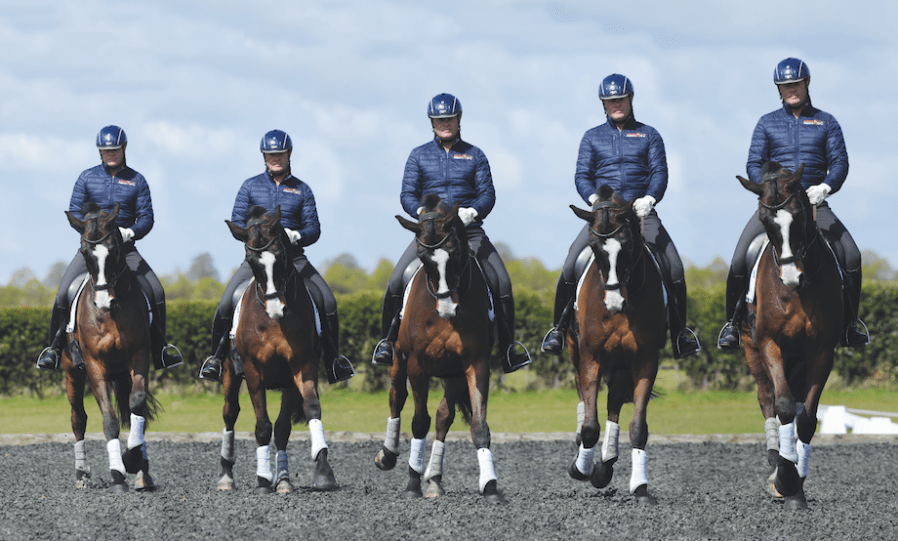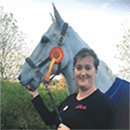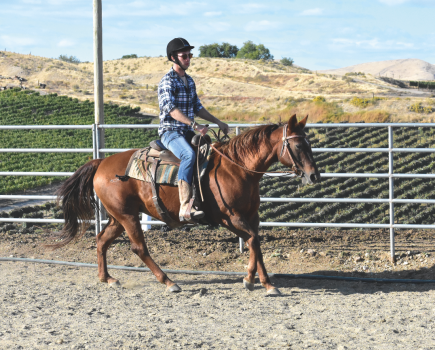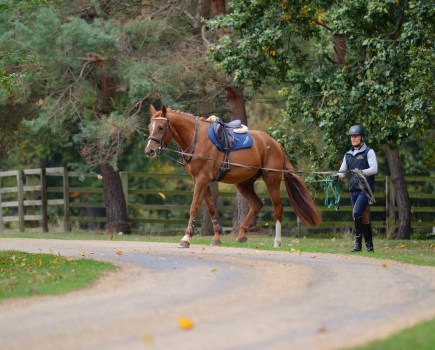Leg yield is the easiest lateral movement to teach a horse, providing you know how to apply the correct aids. It isn’t just for dressage riders and all horses will benefit from doing it.
It doesn’t have to be ridden in an arena either — a field or out hacking also work well. In fact, teaching a horse to move away from your leg is really useful as it makes riding past spooky objects, or opening and shutting gates, much easier when you’re hacking.
“Try thinking of lateral work as yoga for your horse. It improves their balance, relaxation in the frame and suppleness,” says UKCC Level 2 dressage coach Wade Barley.
“Every day you will be asking your horse to do simple lateral movements without even realising. When you ask them to move over in the stable, or to move around you as you close the field gate — these are lateral movements.
“Asking for them from the ground will help your horse to understand what you want when you use your leg to ask them to move over when riding,” adds Wade.
Reasons to ride leg yield
Leg yield is a great straightening and supplying exercise that can be ridden in walk, trot and canter when the correct aids are applied. It teaches a horse to open their shoulder and to step further underneath their body with the hindleg. This builds a better connection and improves engagement.
In leg yield, the horse moves on two tracks: forwards and sideways. Their body should be straight with a small amount of flexion at the poll away from the lateral direction in which they’re moving.
This movement can also be used out hacking to help you pass obstacles that the horse is unsure about. Asking to move away from the object, if it’s safe to do so, helps keep the horse listening to you and not focusing on the object.
How to introduce leg yield
If you’ve not ridden leg yield before, or are teaching a young/green horse this movement, Wade suggests trying these exercises:
1 Inside flexion on a straight line
In walk, ride off the track. See if you can ride the horse in a straight line with slight inside flexion at the poll. This may be trickier than you think. Feel what happens to the horse’s body as you ask for the flexion and what you need to do to keep them travelling in a straight line.
2 Spiralling in and out on a circle
On a 20m circle in walk, play about with your aids to move your horse on to a smaller circle and then leg yield back out again on to a larger circle.
To reduce the circle, use your outside leg to ask your horse to move their body on to a smaller circle — only aim for a 15m circle to begin with. Then use your inside leg to move the horse over and back out onto a 20m circle.
Aids for leg yield left
The most common way to ride leg yield is from the three-quarter line back to the outside track. Asking for it on the three-quarter line can help your horse get the idea as they will more than likely want to move back to the track. Once you’ve mastered it in walk, try it in trot.
The following aids are for leg yield left while riding on the right rein:
- Turn off the outside track on the short side of our schooling area on to the three-quarter line.
- Ride straight ahead for a couple of strides.
- Ask for a little bit of inside (right) flexion at the poll so that the horse is looking away from the direction they’re travelling in. Using your right leg on the girth, ask your horse to leg yield to the left.
- Keep your left leg at the girth so you can use it to stop your horse from moving over too quickly.
- Your left hand controls the speed.
- Keep asking your horse to move forwards and sideways step by step back to the track. Aim to keep their body parallel to the long side.
- Be mindful of the flexion, which is subtle — a common error made in leg yield is having too much neck bend.
- Once you are back on the outside track continue on the right rein around the school. Repeat the exercise down the next three-quarter line.
Aids for leg yield right
For leg yield right while riding on the left rein, the aids are:
- Ask for a little bit of inside (left flexion) at the poll.
- Ask your horse to move over to the right using your left leg on the girth.
- Keep your right leg on the girth and use it to prevent your horse moving over too quickly.
- Your right hand controls the speed.
- Your left hand helps to maintain the inside flexion.
Rider position
Look up and ahead when riding leg yield. It is tempting to look down at the horse, but this changes your balance in the saddle and affects the horse’s too.
Be mindful of where your hands are. At no point should your reins cross over the withers. Your inside hand is vulnerable to this, especially if you ask for too much inside flexion. Keep your hands in their usual position, clear of the withers, and focus on your seat and leg aids while riding leg yield.
Changing the rein
Leg yield can be used to change the rein when you’re schooling too. For example, when riding on the right rein:
- Turn on to the three-quarter line.
- Apply the aids to leg yield right (with inside flexion to the left).
- When you get to the centre line, ride straight forward.
- At the end of the centre line, turn left.
- You are now riding on the left rein.
Leg yield aids from the ground
Leg yield can be started on the ground. Chances are you already do this as part of your day-to-day management of your horse. When they are tied up to be groomed or tacked up, for example, and you need them to move away from the fence/gate.
To ask for leg yield from the ground:
- Stand at your horse’s side and ask your horse to move away from pressure applied to their side, on or just behind the girth area, using your hand and pushing gently.
- As you do this, say a simple verbal command, such as “and over” or “move over” or simply “over”.
- Remember to do this in both directions.
- When you progress to doing leg yield in the saddle, your leg should nudge the horse at the same place on their side, on or just behind the girth, with gentle pushes, while repeating the verbal cue you used on the ground.
- Be mindful that you don’t want the horse to move with their quarters first. This will happen if you apply pressure too far back (with your hand on the ground or your leg when in the saddle).
- If you think your horse hasn’t grasped the meaning of the leg yield aids, make sure you are applying them clearly and correctly. Repetition is the key to helping a horse learn and understand.
“This simple exercise of ‘yielding’ to the leg is the basis of all lateral work and can be used to help develop bend, straightness and obedience, as well as suppleness and elasticity,” explains British Dressage judge Vikki Hayton.
“It builds up the muscles in the hind leg joints and stretches all the horse’s muscles, especially along the outside of their body. It also helps with practical things like getting the horse on the correct canter lead.”
Leg yield in a dressage test
“At prelim level there is very little lateral work. However, as the turns get more angled, you will naturally be working towards turn-on-the-forehand and starting the development of turn-about-the-forehand,” says Vikki, who runs College Farm Equestrian Centre.
“Turning left at E and right at B, or vice versa, is far easier the more supple your horse is, and lateral work is the beginning of engagement and collection.
“The Scales of Training are being progressed, and your dressage marks will be better if your horse can perform all the movements while staying in balance and being able to move more freely, while staying in a rhythm,” continues Vikki.
“This, in turn, will improve your horse’s confidence and your work will be more harmonious because they will find it far easier.
“As you progress to novice level, the turns become more difficult, and the judge will expect your horse to have more self-carriage and engagement in the transitions. This can only be developed by incorporating lateral work into your training. Leg yield is introduced at elementary level dressage.”
Main image: Wade Barley is shown riding leg yield left © Your Horse Library/Kelsey Media Ltd









